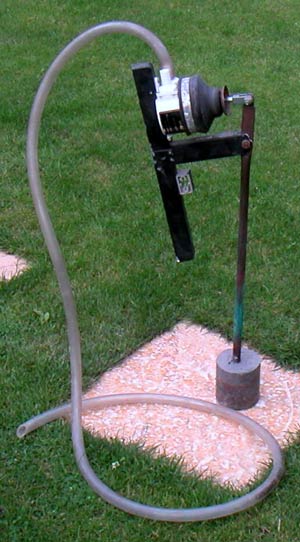SWINGING BRICK NON-ELECTRIC BILGE PUMP
When a boat is kept on a tidal mooring semi-permanently,
there is the problem of water in the bilges. Sometimes it is
seepage of water through the planking, sometimes rainwater,
or blown spray. If some form of electric power is available,
such as a charged battery, then an electric pump, controlled
by a float switch, will look after things. If there is no battery,
then my swinging brick, automatic, non-electric bilge pump might
be found useful.
There have been a few pumps which rely on the
rocking of the boat for an energy source, but the one which
I found to suit me was written up some forty or more years ago
in the Practical Mechanics magazine. It was based on a mechanical
petrol (gas) pump from a car. The bell crank (L-shaped) operating
lever is discarded, and a 12 ins arm linked to the middle of
the diaphragm. The arm is pivoted 1 ins from the top, which
is linked to the diaphragm, and the bottom of the arm has a
lump of lead attached to it. With ¼ ins dia hose attached,
this arrangement pumped out many gallons of bilge water. It
will be apparent that the “Brick” doesn’t
swing; it remains still while the boat does the swinging, whilst
rocking on the mooring.
Unfortunately, the pump was made from die-cast
zinc alloy, and the valves inside were made of brass and stainless
steel. Sea water caused savage corrosion, and the pump swelled
to an enormous size, with the valves clogged up with messy goo.
I was convinced of the viability of the idea,
so I enquired world-wide for a plastic pump which might be sea
water-proof. I found one manufacturer in New Zealand which produced
a pump for medical use, but the price was horrendous.
Eventually I found a little pump normally used
in caravans and mobile homes, for fresh drinking water. It normally
is floor mounted and the visible part is a round rubber half-globe,
which is pressed with the foot to work the pump. The valves
are of neoprene rubber, and therefore corrosion proof. The rubber
half globe is discarded. The operating lever arm is a piece
of ½ inch copper pipe which has had a bit of flat mild
steel bar inserted into the top end, and the tubing is flattened
onto it. This protects the copper from the wear of the pivot
pin, and the clevis, which connects to the centre of the diaphragm.
The weight at the bottom of the lever is a bit of lead cast
into a baked bean can. The piping is 1/2ins bore plastic pipe,
and the mounting frame was contrived from some bits of square
alloy pipe. The swing of the weight can be limited by using
bits of line, or by inserting the whole lot into a piece of
big bore piping.
The manufacture of the pump is Munster Sims, of
Bangor, Northern Ireland, and the type is Whale GP 51 Foot Pump.



